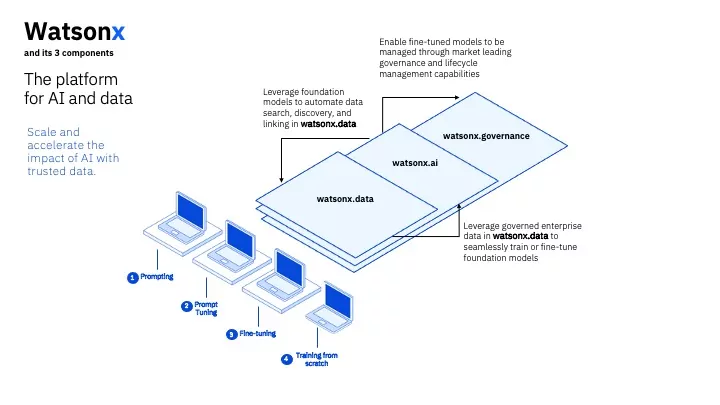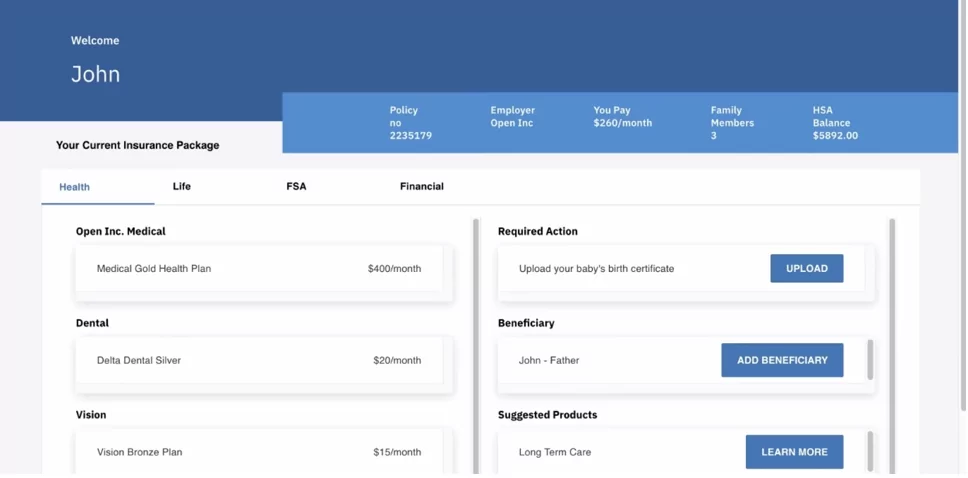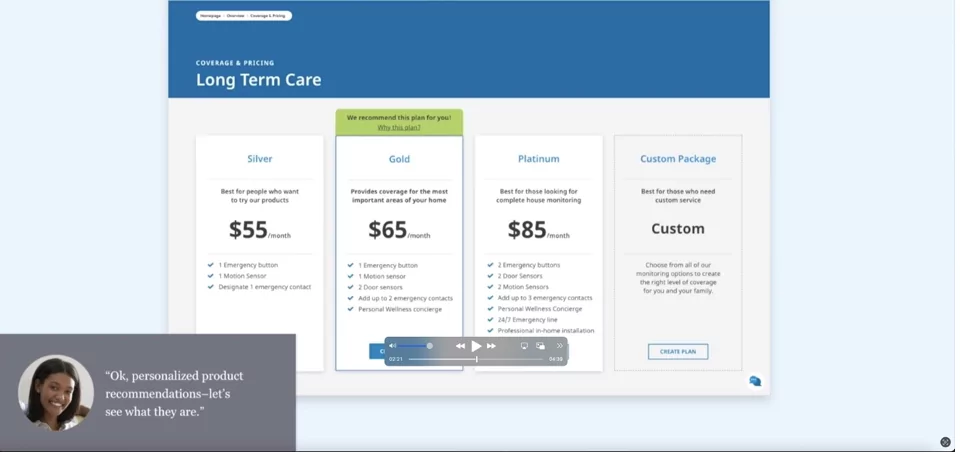<!—->
<!– –>

IBM works with our insurance clients through different fronts, and data from the IBM Institute for Business Value (IBV) identified three key imperatives that guide insurer management decisions:
- Adopt digital transformation to enable insurers to deliver new products, to drive revenue growth and improve customer experience.
- Improve core productivity (business and IT) while reducing cost.
- Embrace incremental application and data modernization utilizing secure hybrid cloud and AI.
Insurers must meet the following key imperatives to facilitate the transformation of their companies:
- Provide digital offerings to their customers.
- Become more efficient.
- Use data more intelligently.
- Address cybersecurity concerns.
- Strive for a resilient and stable offering.
Most insurance companies have prioritized digital transformation and IT core modernization, using hybrid cloud and multi-cloud infrastructure and platforms to achieve the above-mentioned objectives . This approach can accelerate speed-to-market by providing enhanced capabilities for developing innovative products and services, facilitating business growth and improving the overall customer experience in their interactions with the company.
IBM can help insurance companies insert generative AI into their business processes
IBM is among the few global companies that can bring together the range of capabilities needed to completely transform the way insurance is marketed, sold, underwritten, serviced and paid for.
With a strong focus on AI across its wide portfolio, IBM continues to be an industry leader in AI-related capabilities. In a recent Gartner Magic Quadrant, IBM has been placed in the upper right section for its AI-related capabilities (i.e., conversational AI platform, insight engines and AI developer service).
IBM watsonx™ AI and data platform, along with its suite of AI assistants, is designed to help scale and accelerate the impact of AI using trusted data throughout the business.

IBM works with several insurance companies to identify high-value opportunities for using generative AI. The most common insurance use cases include optimizing processes that are used for handling large documents and blocks of text or images. These use cases already represent a quarter of AI workloads today, and there is a significant shift toward enhancing their functionality with generative AI. This enhancement involves extracting content and insights or classifying information to support decision-making, such as in underwriting and claims processing. Focus areas where the use of generative AI capabilities can make a significant difference in the insurance industry include:
- Customer engagement
- Digital labor
- Application modernization
- IT operations
- Cybersecurity
IBM is creating generative AI-based solutions for various use cases, including virtual agents, conversational search, compliance and regulatory processes, claims investigation and application modernization. Below, we provide summaries of some of our current generative AI implementation initiatives.
Customer engagement: Providing insurance coverage involves working with numerous documents. These documents include insurance product descriptions detailing covered items and exclusions, policy or contract documents, premium bills and receipts, as well as submitted claims, explanations of benefits, repair estimates, vendor invoices and more. A significant portion of customer interactions with the insurance company consists of inquiries regarding coverage terms and conditions for various products, understanding the approved claim payment amount, reasons for not paying the submitted claim amount and the status of transactions such as premium receipts, claims payments, policy change requests and more.
As part of our generative AI initiatives, we can demonstrate the ability to use a foundation model with prompt tuning to review the structured and unstructured data within the insurance documents (data associated with the customer query) and provide tailored recommendations concerning the product, contract or general insurance inquiry. The solution can provide specific answers based on the customer’s profile and transaction history, accessing the underlying policy administration and claims data. The ability to instantly analyze extensive customer data, identify patterns to generate insights and anticipate customer needs can result in greater customer satisfaction.
An example of customer engagement is a generative AI-based chatbot we have developed for a multinational life insurance client. The PoC shows the increased personalization of response to insurance product queries when generative AI capabilities are used.

Another chatbot we have developed for an insurance client shows the ability for the policyholder to get a comprehensive view of the coverages provided in an insurance package, including premiums for each of the insurance coverages contained in the package Likewise, it touts the ability to perform a variety of other functions such as adding required documents (e.g., birth certificates), adding beneficiaries investigating insurance products and supplementing current coverage. All these capabilities are assisted by automation and personalized by traditional and generative AI using secure, trustworthy foundation models.


We show below an example of a customer inquiring about a specific dental procedure and receiving a tailored reply based on knowledge of the customer’s existing dental coverages as well as the generative AI chatbot’s ability to have an interactive conversation (similar to that of an expert customer service agent) that is tailored to the customer’s specific needs.

We are currently developing several use cases, which include:
- Obtaining prior authorization for medical procedures.
- Administering health benefits.
- Explaining claims decisions and benefits to policyholders.
- Summarizing claims history.
Insurance agent/contact center agent assistance: Insurance companies have widely deployed voice response units, mobile apps and online, web-based solutions that customers can use for simple inquiries, such as balance due information and claim payment status checks. However, the current set of solutions is limited in functionality and cannot answer more complex customer queries, as listed under customer engagement. As a result, customers often resort to calling the insurance agent or the insurance company’s contact center. Generative AI-based solutions designed for agents can significantly reduce document search time, summarize information and enable advisory capabilities, leading to increased productivity averaging 14–34% or even 42%, and better customer satisfaction metrics. IBM has been implementing traditional AI-based solutions at insurance companies for several years, using products such as IBM watsonx™ Assistant and IBM Watson® Explorer. We are now starting collaborations with a few insurance companies to incorporate foundation models and prompt tuning to enhance agent assistance capabilities.
Risk management: To make underwriting decisions related to property, insurance companies gather a significant amount of external data—including the property data provided in insurance application forms, historical records of floods, hurricanes, fire incidents and crime statistics—for the specific location of the property. While historical data is publicly available from sources such as data.gov, well-established insurance companies also have access to their own underwriting and claims experience data. Currently, using this data for modeling risk involves manually-intensive efforts, and AI capabilities are underutilized.
A current initiative by IBM involves collecting publicly available data relevant to property insurance underwriting and claims investigation to enhance foundation models in the IBM® watsonx™ AI and data platform. The results can then be used by our clients, who can incorporate their proprietary experience data to further refine the models. These models and proprietary data will be hosted within a secure IBM Cloud® environment, specifically designed to meet regulatory industry compliance requirements for hyperscalers. The risk management solution aims to significantly speed up risk evaluation and decision-making processes while improving decision quality.
Code modernization: Many insurance companies with over 50 years of history still rely on systems developed as far back as the ‘70s, often coded in a mix of Cobol, Assembler and PL1. Modernizing these systems requires converting the legacy code into production-ready Java or other programming languages.
IBM is working with several financial institutions using generative AI capabilities to understand the business rules and logic embedded in the existing codebase and support its transformation into a modular system. The transformation process uses the IBM component business model (for insurance) and the BIAN framework (for banking) to guide the redesign. Generative AI also aids in producing test cases and scripts for testing the modernized code.
Addressing industry concerns related to using generative AI
In a study conducted by IBM’s Institute for Business Value (IBV), business leaders expressed concerns about the adoption of generative AI. The major concerns relate to:
- Explainability: 48% of the leaders IBM interviewed believe that decisions made by generative AI are not sufficiently explainable.
- Ethics: 46% are concerned about the safety and ethical aspects of generative AI.
- Bias: 46% believe that generative AI will propagate established biases.
- Trust: 42% believe generative AI cannot be trusted.
- Compliance: 57% believe regulatory constraints and compliance are significant barriers.
IBM addresses the above concerns through its suite of watsonx platform components: IBM watsonx.ai™ AI studio, IBM watsonx.data™ data store and IBM watsonx.governance™ toolkit for AI governance. Specifically, watsonx.governance provides the capabilities to monitor and govern the entire AI lifecycle by providing transparency, accountability, lineage, data tracking, and bias and fairness monitoring in the models. The end-to-end solution provides insurance company leaders with features that enable responsible, transparent and explainable AI workflows when using both traditional and generative AI.
As described above, we have identified many high-value opportunities to help insurance companies get started with using generative AI for the digital transformation of their insurance business processes. In addition, generative AI technology can be used to provide new content types such as articles (for insurance product marketing), personalized content or emails for customers, and even aid in content generation like programming code to increase developer productivity.
IBM experience working with clients indicate significant productivity gains when using generative AI, including improving HR processes to streamline tasks such as talent acquisition and managing employee performance; making customer care agents more productive by enabling them to focus on higher value interactions with customers (while digital channel virtual assistants using generative AI handle simpler inquiries); and saving time and effort in modernizing legacy code by using generative AI to help with code refactoring and conversion.
To discuss these topics in more detail, please email Kishore Ramchandani and Anuj Jain.
Put watsonx generative AI to work
Was this article helpful?
YesNo
More from Artificial intelligence

January 18, 2024
Unlocking the power of chatbots: Key benefits for businesses and customers
6 min read – Chatbots can help your customers and potential clients find or input information quickly by instantly responding to requests that use audio input, text input or a combination of both, eliminating the need for human intervention or manual research. Chatbots are everywhere, providing customer care support and assisting employees who use smart speakers at home, SMS, WhatsApp, Facebook Messenger, Slack and numerous other applications. The latest artificial intelligence (AI) chatbots, also known as intelligent virtual assistants or virtual agents, not only…

January 16, 2024
Join us at the forefront of AI for business: Think 2024
< 1 min read – You want to use AI to accelerate productivity and innovation for your business. You need to move beyond experimentation to scale. You have to move fast. Join us in Boston for Think 2024, a unique and engaging experience that will guide you on your AI for business journey, no matter where you are on the road. From building AI readiness with a thoughtful hybrid cloud approach, to scaling AI across core business functions and industry needs, to embedding AI into…

January 12, 2024
Meet the devops.automation platform that’s built for the enterprise
4 min read – devops.automation is a software delivery platform with five core components and open connections to large language models (LLM) and artificial AI that’s designed to help you scale and accelerate the delivery of applications, AI and integrations across a business. The core components of devops.automation include support for: planning and managing projects quickly and easily; creative tools to model and code with real-time generation and build applications; AI vision and AI pattern analysis to minimize the effort of testing; intelligent delivery…

January 11, 2024
5 ways IBM helps manufacturers maximize the benefits of generative AI
2 min read – While still in its early stages, generative AI can provide powerful optimization capabilities to manufacturers in the areas that matter most to them: productivity, product quality, efficiency, worker safety and regulatory compliance. Generative AI can work with other AI models to increase accuracy and performance, such as augmenting images to improve quality evaluation of a computer vision model. With generative AI, there are fewer “misreads” and overall better-quality assessments. Let’s look at five specific ways IBM® delivers expert solutions that…
IBM Newsletters
Get our newsletters and topic updates that deliver the latest thought leadership and insights on emerging trends.
Subscribe now
More newsletters
- SEO Powered Content & PR Distribution. Get Amplified Today.
- PlatoData.Network Vertical Generative Ai. Empower Yourself. Access Here.
- PlatoAiStream. Web3 Intelligence. Knowledge Amplified. Access Here.
- PlatoESG. Carbon, CleanTech, Energy, Environment, Solar, Waste Management. Access Here.
- PlatoHealth. Biotech and Clinical Trials Intelligence. Access Here.
- Source: https://www.ibm.com/blog/ai-based-solutions-for-insurance-companies/



